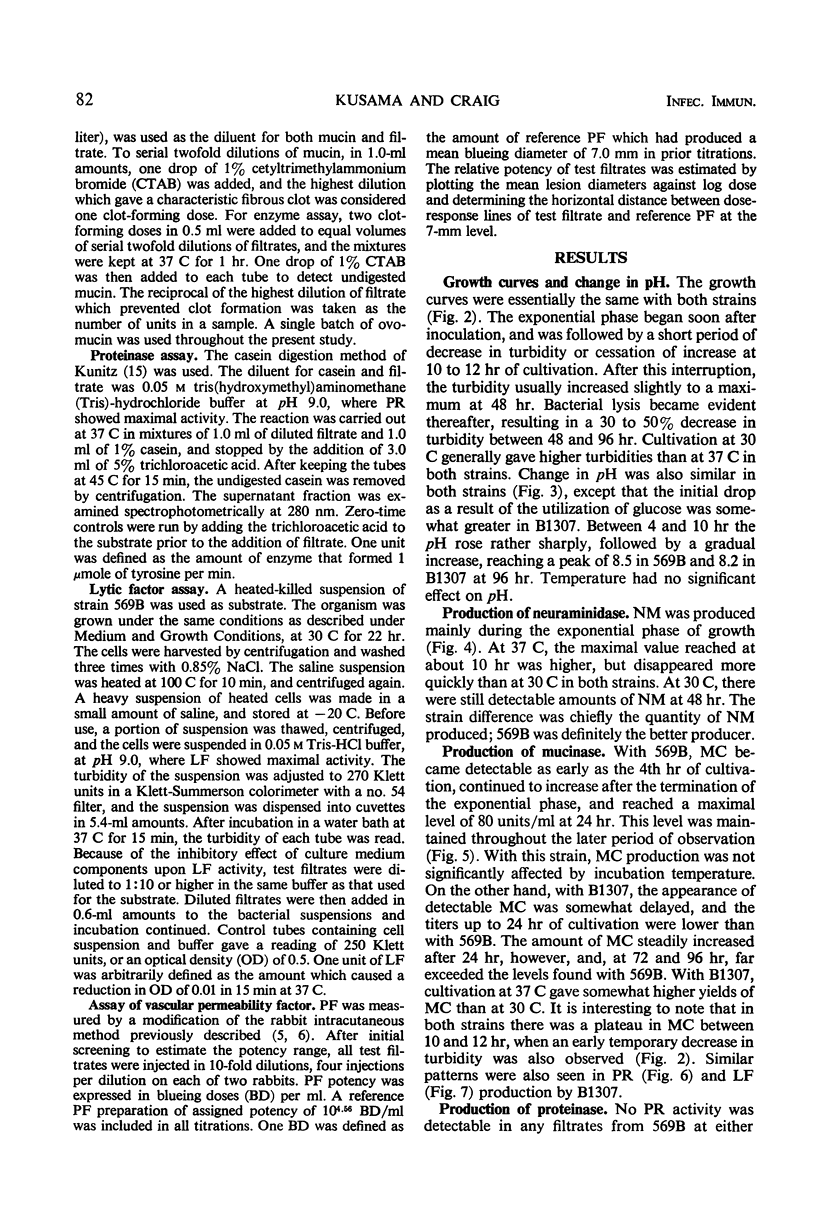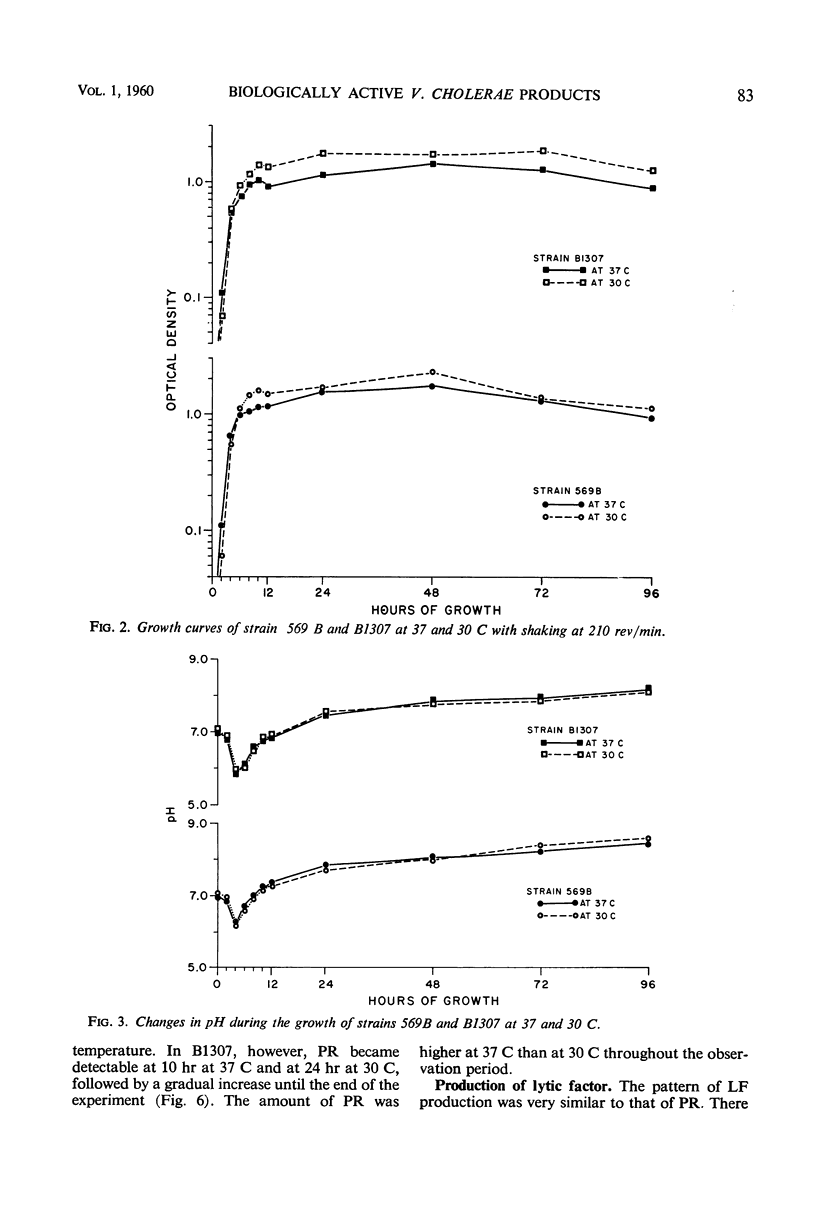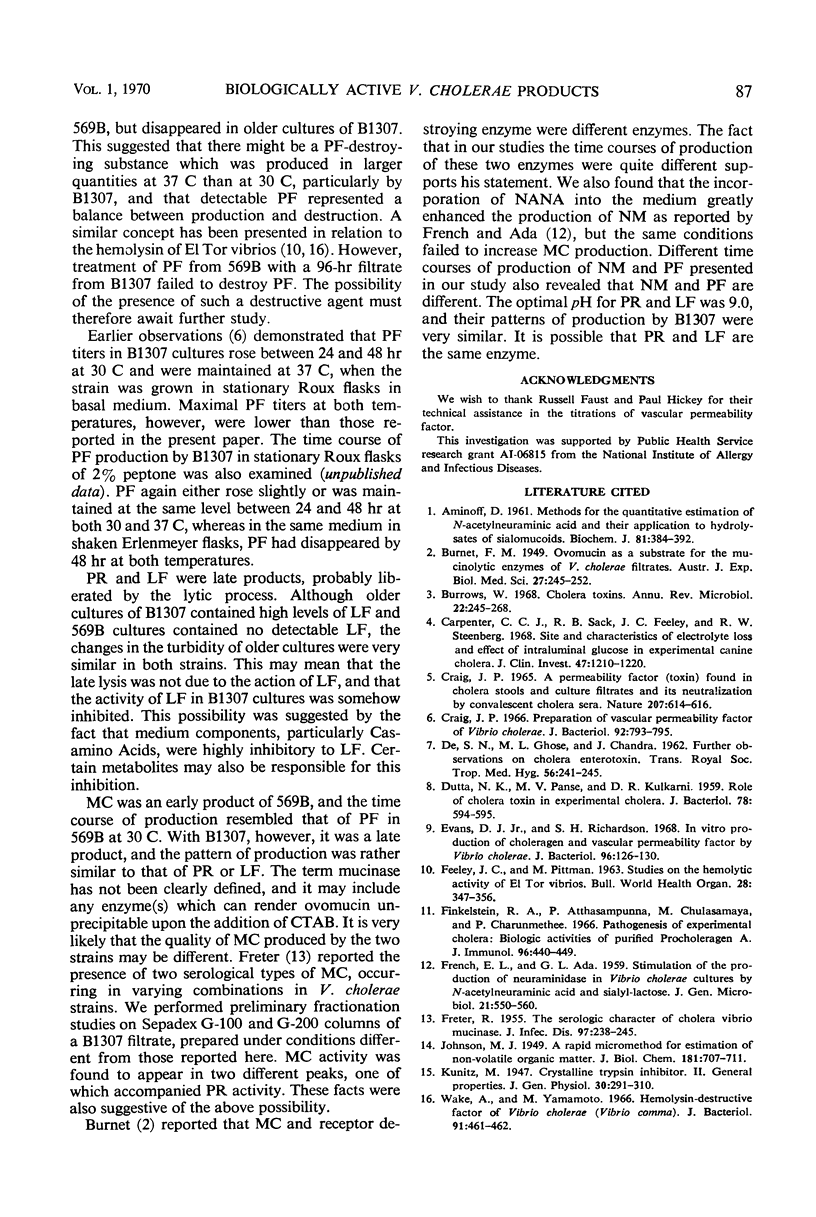Abstract
Strains Inaba 569B and Ogawa B1307 of Vibrio cholerae were grown in shaken Casamino Acids-yeast extract-glucose medium at 30 and 37 C for 4 days. Time courses of production of neuraminidase (NM), mucinase (MC), proteinase (PR), lytic factor (LF), and vascular permeability factor (PF) were compared by examining culture filtrates taken at various intervals. With both strains, turbidities were generally higher at 30 C than at 37 C. Both strains showed marked cellular lysis after maximal growth was attained at 48 hr at both temperatures. NM and PF were early products, maximal yield being attained within 24 hr. At 37 C, the peak of NM reached at about 10 hr was higher than at 30 C, but disappeared more quickly. The yield of PF was greater at 30 C than at 37 C, and 569B produced more PF. With 569B, PF appeared during the exponential phase, but continued to increase substantially after this phase terminated. At 30 C, the peak attained at 24 hr by 569B was well maintained until 96 hr, but fell moderately at 37 C. In contrast, with B1307 PF fell sharply and virtually disappeared after 24 hr at both temperatures, with concomitant rise in late products. PR and LF were late products; neither was detected in 569B filtrates, whereas older cultures of B1307 showed high levels of both enzymes. MC was an early product with 569B, resembling PF, whereas it was a late product with B1307.
Full text
PDF







Images in this article
Selected References
These references are in PubMed. This may not be the complete list of references from this article.
- AMINOFF D. Methods for the quantitative estimation of N-acetylneuraminic acid and their application to hydrolysates of sialomucoids. Biochem J. 1961 Nov;81:384–392. doi: 10.1042/bj0810384. [DOI] [PMC free article] [PubMed] [Google Scholar]
- Burrows W. Cholera toxins. Annu Rev Microbiol. 1968;22:245–268. doi: 10.1146/annurev.mi.22.100168.001333. [DOI] [PubMed] [Google Scholar]
- Carpenter C. C., Sack R. B., Feeley J. C., Steenberg R. W. Site and characteristics of electrolyte loss and effect of intraluminal glucose in experimental canine cholera. J Clin Invest. 1968 May;47(5):1210–1220. doi: 10.1172/JCI105810. [DOI] [PMC free article] [PubMed] [Google Scholar]
- Craig J. P. A permeability factor (toxin) found in cholera stools and culture filtrates and its neutralization by convalescent cholera sera. Nature. 1965 Aug 7;207(997):614–616. doi: 10.1038/207614a0. [DOI] [PubMed] [Google Scholar]
- Craig J. P. Preparation of the vascular permeability factor of Vibrio cholerae. J Bacteriol. 1966 Sep;92(3):793–795. doi: 10.1128/jb.92.3.793-795.1966. [DOI] [PMC free article] [PubMed] [Google Scholar]
- DE S. N., GHOSE M. L., CHANDRA J. Further observations on cholera enterotoxin. Trans R Soc Trop Med Hyg. 1962 May;56:241–245. doi: 10.1016/0035-9203(62)90161-x. [DOI] [PubMed] [Google Scholar]
- DUTTA N. K., PANSE M. V., KULKARNI D. R. Role of cholera a toxin in experimental cholera. J Bacteriol. 1959 Oct;78:594–595. doi: 10.1128/jb.78.4.594-595.1959. [DOI] [PMC free article] [PubMed] [Google Scholar]
- Evans D. J., Jr, Richardson S. H. In vitro production of choleragen and vascular permeability factor by Vibrio cholerae. J Bacteriol. 1968 Jul;96(1):126–130. doi: 10.1128/jb.96.1.126-130.1968. [DOI] [PMC free article] [PubMed] [Google Scholar]
- FEELEY J. C., PITTMAN M. Studies on the haemolytic activity of El Tor vibrios. Bull World Health Organ. 1963;28(3):347–356. [PMC free article] [PubMed] [Google Scholar]
- FRENCH E. L., ADA G. L. Stimulation of the production of neuraminidase in Vibrio cholerae cultures by N-acetylneuraminic acid and sialyl-lactose. J Gen Microbiol. 1959 Dec;21:550–560. doi: 10.1099/00221287-21-3-550. [DOI] [PubMed] [Google Scholar]
- FRETER R. The serologic character of cholera Vibrio mucinase. J Infect Dis. 1955 Nov-Dec;97(3):238–245. doi: 10.1093/infdis/97.3.238. [DOI] [PubMed] [Google Scholar]
- Finkelstein R. A., Atthasampunna P., Chulasamaya M., Charunmethee P. Pathogenesis of experimental cholera: biologic ativities of purified procholeragen A. J Immunol. 1966 Mar;96(3):440–449. [PubMed] [Google Scholar]
- JOHNSON M. J. A rapid micromethod for estimation of non-volatile organic matter. J Biol Chem. 1949 Dec;181(2):707–711. [PubMed] [Google Scholar]
- Wake A., Yamamoto M. Hemolysin-destructive factor of Vibrio cholerae (Vibrio comma). J Bacteriol. 1966 Jan;91(1):461–462. doi: 10.1128/jb.91.1.461-462.1966. [DOI] [PMC free article] [PubMed] [Google Scholar]



